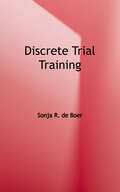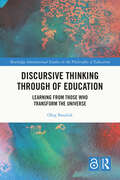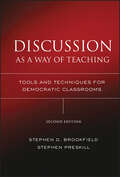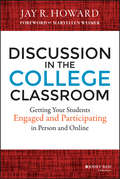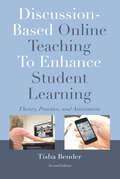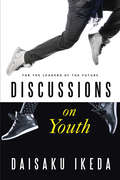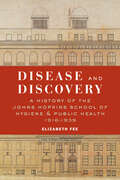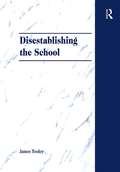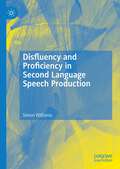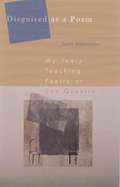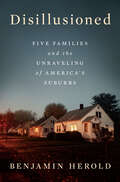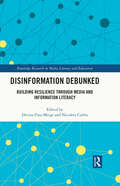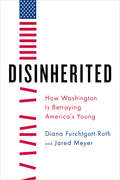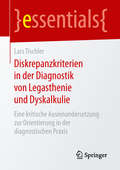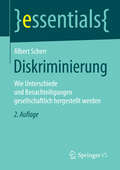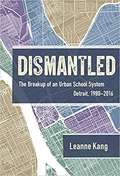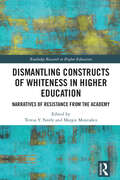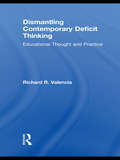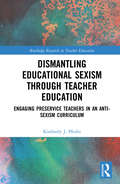- Table View
- List View
Discrete Choice Methods with Simulation
by Kenneth E. TrainThis book describes the new generation of discrete choice methods, focusing on the many advances that are made possible by simulation. Researchers use these statistical methods to examine the choices that consumers, households, firms, and other agents make. Each of the major models is covered: logit, generalized extreme value, or GEV (including nested and cross-nested logits), probit, and mixed logit, plus a variety of specifications that build on these basics. Simulation-assisted estimation procedures are investigated and compared, including maximum simulated likelihood, method of simulated moments, and method of simulated scores. Procedures for drawing from densities are described, including variance reduction techniques such as anithetics and Halton draws. Recent advances in Bayesian procedures are explored, including the use of the Metropolis-Hastings algorithm and its variant Gibbs sampling. No other book incorporates all these fields, which have arisen in the past 20 years. The procedures are applicable in many fields, including energy, transportation, environmental studies, health, labor, and marketing.
Discrete Trial Training
by Sonja R. DeBoerDiscrete trial training (DTT) is a method of teaching individuals with autism spectrum disorder (ASD) based on applied behavior analysis (ABA). Skills are broken into discrete steps and then taught in massed trials. With DTT, steps are taught one at a time, instead of teaching an entire skill all at once. Concepts covered include errorless learning, methods of reinforcement, and how to use behavior momentum. The text explains how to collect, interpret, and use data to make teaching decisions. Finally, the text details a method for evaluating implementation of DTT.
Discursive Thinking Through of Education: Learning from Those Who Transform the Universe (Routledge International Studies in the Philosophy of Education)
by Oleg BazalukThis book is a contribution to the philosophical discourse on education. Education is considered as a tool of philosophy. Education (paideia) and politics (politeia) are equal in importance for building a sustainable society free from feud and unhappiness. Discursive thinking through of education is based on Plato’s dialogues and the results of epistemological, metaphysical and ethical research in the fields of cosmology, biology and neuroscience. The author demonstrates the potential of the threefold scheme of philosophy, a Platone philosophandi ratio triplex, for ordering individual and collective discourse and way of life in strict accordance with the intelligible complexity of the expanding cosmos. An essential read for students and scholars interested in the crossroad between education and philosophy.
Discussing Bilingualism in Deaf Children: Essays in Honor of Robert Hoffmeister
by Charlotte EnnsThis collection unites expert scholars in a comprehensive survey of critical topics in bilingual deaf education. Drawing on the work of Dr. Robert Hoffmeister, chapters explore the concept that a strong first language is critical to later learning and literacy development. In thought-provoking essays, authors discuss the theoretical underpinnings of bilingual deaf education, teaching strategies for deaf students, and the unique challenges of signed language assessment. Essential for anyone looking to expand their understanding of bilingualism and deafness, this volume reflects Dr. Hoffmeister’s impact on the field while demonstrating the ultimate resilience of human language and literacy systems.
Discussing Mere Christianity Study Guide: Exploring the History, Meaning, and Relevance of C.S. Lewis's Greatest Book
by Devin BrownIn this eight-session video group study (DVD/digital video sold separately), you will discover why Mere Christianity by C.S. Lewis is one of the most read and beloved Christian books of all time. But seventy years later from when it was first delivered on radio, what relevance does it have to our world today? Host Eric Metaxas and a variety of Christian leaders−including Philip Yancey, Alister McGrath, Devin Brown, Paul McCusker, Douglas Gresham, and others−help us understand the timeless message of C. S. Lewis in fresh ways for a new generation.The first purpose of this video study is to explore the positive ideas that C.S. Lewis has so eloquently written about in Mere Christianity for those who already call themselves Christian. The second purpose is to explain in an engaging, winsome and non-threatening way the basic tenets of the Christian faith as illustrated by C.S. Lewis to those who do not claim to be Christian. This study aims to fulfill the vision of C.S. Lewis of reaching people from all faith backgrounds.Sessions include:Our Sense of Right and WrongWhat's Behind Our Sense of Right and WrongThe Rival Conceptions of GodFree Will and the Shocking AlternativeChristian Behavior and the Great Sin of PrideThe Christian Virtue of HopeGod in Three PersonsCounting the CostDesigned for use with the Discussing Mere Christianity Video Study 9780310699859 (sold separately).
Discussion as a Way of Teaching
by Stephen D. Brookfield Stephen PreskillThoroughly revised and updated, the second edition of the landmark book Discussion as a Way of Teaching shows how to plan, conduct, and assess classroom discussions. Stephen D. Brookfield and Stephen Preskill suggest exercises for starting discussions, strategies for maintaining their momentum, and ways to elicit diverse views and voices. The book also includes new exercises and material on the intersections between discussion and the encouragement of democracy in the classroom. This revised edition expands on the original and contains information on adapting discussion methods in online teaching, on using discussion to enhance democratic participation, and on the theoretical foundations for the discussion exercises described in the book. Throughout the book, Brookfield and Preskill clearly show how discussion can enliven classrooms, and they outline practical methods for ensuring that students will come to class prepared to discuss a topic. They also explain how to balance the voices of students and teachers, while still preserving the moral, political, and pedagogic integrity of discussion.
Discussion in the College Classroom
by Maryellen Weimer Jay R. HowardKeep students engaged and actively learning with focused, relevant discussion Second only to lecture as the most widely used instructional strategy, there's no better method than classroom discussion to actively engage students with course material. Most faculty are not aware that there is an extensive body of research on the topic from which instructors can learn to facilitate exceptional classroom discussion. Discussion in the College Classroom is a practical guide which utilizes that research, frames it sociologically, and offers advice, along with a wide variety of strategies, to help you spark a relevant conversation and steer it toward specific learning goals. Applicable across a spectrum of academic disciplines both online and on campus, these ideas will help you overcome the practical challenges and norms that can undermine discussion, and foster a new atmosphere of collaborative learning and critical thinking. Higher education faculty are increasingly expected to be more intentional and reflective in their pedagogical practice, and this guide shows you how to meet those expectations, improve student outcomes, and tackle the perennial problem of lagging engagement. Thoroughly grounded in the scholarship of teaching and learning, this book gives you concrete guidance on integrating discussion into your courses. You'll learn to: Overcome the challenges that inhibit effective discussion Develop classroom norms that facilitate discussion Keep discussion focused, relevant, and productive Maximize the utility of online student discussions The kind of discussion that improves learning rarely arises spontaneously. Like any pedagogical technique, careful planning and smart strategy are the keys to keeping students focused, engaged, and invested in the conversation. Discussion in the College Classroom helps you keep the discussion applicable to the material at hand while serving learning goals.
Discussion-Based Online Teaching To Enhance Student Learning: Theory, Practice and Assessment
by Tisha BenderThe new edition of what is now considered a classic on online learning has been expanded by about a third to reflect new opportunities offered by social media, new insights and ideas derived from the author’s teaching in the eight years since she wrote the first edition, as well as from extensive research in the latest literature. In particular, Tisha Bender investigates whether the existing paradigm of teaching and learning has been changed, not so much because of the advent of the Internet, but because of the potential divide between the expectations and practices of students who are “digital natives” of the digital revolution, and those of their teachers who are mostly “digital immigrants”. She addresses the question: do we need to change the way we teach in order to reach and engage digital natives fruitfully and enjoyably in their education.This accessible and comprehensive book offers an engaging and practical approach to online teaching that is rooted in the author's experience and enthusiasm for creating a virtual environment that engages students and fosters their deep learning. This is a book for all educators and administrators in higher education, in any discipline, engaged in, or contemplating offering, online classes that involve discussion or collaborative learning. It is relevant both to faculty teaching a hybrid and face-to-face classes, and courses conducted entirely online.
Discussions on Youth (For Leaders of the Future)
by Daisaku IkedaDaisaku Ikeda, who offers spiritual leadership to 12 million Soka Gakkai Buddhists throughout the world, responds to the complicated issues facing American young people in a straight-forward question and answer format. Expanding on his popular The Way of Youth, he addresses young people as being the leaders of the future, and with warmth and understanding he urges young people to see the great potential they have as the hope for humanity. The book also provides easy-to-understand explanations of Nichiren Buddhism and the benefits of practice.
Disease and Discovery: A History of the Johns Hopkins School of Hygiene & Public Health, 1916–1939
by Elizabeth FeeThe story of a world-renowned institution and “a broad investigation of early twentieth-century public health ideology in America” (Journal of the American Medical Association).At the end of the nineteenth century, public health was the province of part-time political appointees and volunteer groups of every variety. Public health officers were usually physicians, but they could also be sanitary engineers, lawyers, or chemists—there was little agreement about the skills and knowledge necessary for practice. In Disease and Discovery, Elizabeth Fee examines the conflicting ideas about public health’s proper subject and scope and its search for a coherent professional unity and identity. She draws on the debates and decisions surrounding the establishment of what was initially known as the Johns Hopkins School of Hygiene and Public Health, the first independent institution for public health research and education, to crystallize the fundamental questions of the field.Many of the issues of public health education in the early twentieth century are still debated today. What is the proper relationship of public health to medicine? What is the relative importance of biomedical, environmental, and sociopolitical approaches to public health? Should schools of public health emphasize research skills over practical training? Should they provide advanced training and credentials for the few or simpler educational courses for the many?Fee explores the many dimensions of these issues in the context of the founding of the Johns Hopkins school. She details the efforts to define the school’s structure and purpose, select faculty and students, and organize the curriculum, and she follows the school’s growth and adaptation to the changing social environment through the beginning of World War II. As Fee demonstrates, not simply in its formation but throughout its history, the School of Hygiene served as a crucible for the forces shaping the public health profession as a whole.
Disestablishing the School: De-Bunking Justifications for State Intervention in Education
by James TooleyThat governments are, and will always be, involved in education, is taken for granted by the majority of educationalists. Recent market reforms are condemned, because they appear to undermine state intervention in education. But are justifications for state intervention in education philosophically sound? Is the attack on markets justified? In Disestablishing the School, Dr Tooley explores these issues, setting recent educational policy debates in the broader context of debates in moral and political philosophy, and philosophy of economics. Topical issues to do with equality of opportunity, education for democracy, education for autonomy, democratic control of the curriculum, and education as a public good are examined. None of these survive as a critique of markets in education, nor as a justification for state intervention in education. In undermining these arguments, Dr Tooley argues that the case for the disestablishment of the school, for the separation of school and state, can be philosophically sustained.
Diseñadas a Su imagen: Cómo Cristo restaura la belleza de Su imagen en la mujer
by Miguel Núñez Javier Domínguez Sugel Michelén Geraldina de Domínguez Catherine Scheraldi de NúñezDescubre cómo sanar las heridas de tu alma y redescubrir tu verdadero valor como mujer creada a imagen de Dios. Este libro te guiará a vivir con propósito, esperanza y una identidad renovada en Cristo.¿Sientes que las expectativas del mundo y las verdades del evangelio te dividen? ¿Anhelas sanar una imagen quebrantada en tu interior y entender tu verdadero valor? Este libro te ayudará a redescubrir la dignidad, la belleza y el propósito que Dios te dio al crearte a Su imagen, ofreciendo una guía para vivir como una mujer que refleja a su Creador.Diseñadas a Su imagen es una invitación a un viaje transformador, desde el jardín del Edén hasta la restauración completa que se encuentra en Cristo. A través de una sólida exposición bíblica, los reconocidos autores Javier Domínguez, Miguel Núñez, Sugel Michelén, Geraldina de Domínguez y Catherine Scheraldi de Núñez te guiarán para que mires más allá de los estándares del mundo y abraces la identidad divina con la que fuiste formada.Este libro te ayudará a:Comprender tu valor: Entiende que tu dignidad no depende de estándares humanos, sino de haber sido creada a imagen de un Dios majestuoso.Sanar tus heridas: Descubre cómo Cristo puede tomar el dolor, el menosprecio y el abuso para transformarlos para tu bien y moldearte a Su imagen.Vivir con esperanza: Aprende a vivir entre el dolor de un mundo caído y la esperanza segura de la gloria futura, entendiendo que tu sufrimiento nunca es en vano.Reflejar a Cristo: Renueva tu mente y corazón para deshacerte de los malos hábitos y vivir tu nueva identidad en Cristo, pareciéndote cada día más a Él.Ideal para:Mujeres cristianas que buscan un estudio bíblico profundo sobre la feminidad bíblica.Grupos de estudio para mujeres y discipulado.Un regalo de aliento para una amiga, hermana o madre.Diseñadas a Su imagen es un recurso valioso para toda mujer que anhela vivir reflejando a su Creador en cada área de su vida. Acepta la invitación a anclar tu alma en la verdad de las Escrituras, abrazar tu llamado y caminar con esperanza hacia la gloria que te espera.
Disfluency and Proficiency in Second Language Speech Production
by Simon WilliamsThis book explores the concept of disfluency in speech production, particularly as it occurs in the context of second language acquisition. Drawing on examples from learner speech at three levels (beginner, intermediate and advanced), the author argues that acquiring target language norms for performing disfluency is essential to an individual being recognized as fluent in a language by fellow-speakers. Starting with a survey of the psycholinguistic research in this area, he then applies a sociolinguistic lens to examine how a learner's social and educational background impacts the types of disfluencies in their speech. This book will be of interest to readers in fields such as (applied) linguistics and second language acquisition, psychology and education.
Disguised as a Poem: My Years Teaching Poetry at San Quentin
by Judith TannenbaumMemoir of teaching poetry at a California prison. Includes some of the prisoners' poems.
Dishwasher: Passbooks Study Guide (Career Examination Series)
by National Learning CorporationThe Dishwasher Passbook® prepares you for your test by allowing you to take practice exams in the subjects you need to study. It provides hundreds of questions and answers in the areas that will likely be covered on your upcoming exam, including but not limited to: dishwashing and hygiene; verbal abilities; understanding and interpreting written material; arithmetic; and other related areas.
Disillusioned: Five Families and the Unraveling of America's Suburbs
by Benjamin Herold"Astonishingly important.&” —Alex Kotlowitz, The AtlanticThrough the stories of five American families, a masterful and timely exploration of how hope, history, and racial denial collide in the suburbs and their schoolsOutside Atlanta, a middle-class Black family faces off with a school system seemingly bent on punishing their teenage son. North of Dallas, a conservative white family relocates to an affluent suburban enclave, but can&’t escape the changes sweeping the country. On Chicago&’s North Shore, a multiracial mom joins an ultraprogressive challenge to the town&’s liberal status quo. In Compton, California, whose suburban roots are now barely recognizable, undocumented Hispanic parents place their gifted son&’s future in the hands of educators at a remarkable elementary school. And outside Pittsburgh, a Black mother moves to the same street where author Benjamin Herold grew up, then confronts the destructive legacy left behind by white families like his.Disillusioned braids these human stories together with penetrating local and national history to reveal a vicious cycle undermining the dreams upon which American suburbia was built. For generations, upwardly mobile white families have extracted opportunity from the nation&’s heavily subsidized suburbs, then moved on before the bills for maintenance and repair came due, leaving the mostly Black and Brown families who followed to clean up the ensuing mess. But now, sweeping demographic shifts and the dawning realization that endless expansion is no longer feasible are disrupting this pattern, forcing everyday families to confront a truth their communities were designed to avoid: The suburban lifestyle dream is a Ponzi scheme whose unraveling threatens us all.How do we come to terms with this troubled history? How do we build a future in which all children can thrive? Drawing upon his decorated career as an education journalist, Herold explores these pressing debates with expertise and perspective. Then, alongside Bethany Smith—the mother from his old neighborhood, who contributes a powerful epilogue to the book—he offers a hopeful path toward renewal. The result is nothing short of a journalistic masterpiece.
Disinformation Debunked: Building Resilience through Media and Information Literacy (Routledge Research in Media Literacy and Education)
by Divina Frau-Meigs Nicoleta CorbuDisinformation Debunked: Building Resilience through Media and Information Literacy examines the way media and information literacy (MIL) can address disinformation in conjunction with fact-checkers and developers, to benefit from the expertise of these fields in fighting disinformation.The book highlights the underlying stakes that are involved in the fight against disinformation, from producing smart tools to generalizing their use beyond the journalistic profession. It considers the MIL theories and methodologies at work in the digital era, especially from the perspective of digital visual literacy. Offering a comparative study of four European national experiences (France, Romania, Spain, and Sweden), the authors also make public policy recommendations to improve the fight against disinformation.This book is of great importance to students, scholars, and educators working on media and information literacy, digital media, journalism, mass communication, misinformation and disinformation.
Disinherited
by Diana Furchtgott-Roth Jared MeyerTens of millions of Americans are between the ages of 18 and 30. These Americans, known as millennials, are, or soon will be, entering the workforce. For them, achieving success will be more difficult than it was for young people in the past.This is not because they are less intelligent, they have worked less hard, or they are any less deserving of the American dream. It is because Washington made decisions that render their lives more difficult than those of their parents or grandparents. Their younger siblings and their children will be even worse off, allbecause Washington has refused to fix the problem.This book describes the personal stories of several members of this disinherited generation. Their experiences are not unique. It is impossible to hear these stories and not understand that holding back a nation's young is the antithesis of fairness and no way to make economic or social progress.Their stories are an indictment of America's treatment of its young. A nation that prides itself on its future has mortgaged it. A nation that historically took pride in its youth culture has become a nation that steals from its young. People who should have fulfilling, productive lives are sidelined, unemployed, or underemployed.Meanwhile, America expects millennials and others of the disinherited generation to pay higher taxes for government programs that benefit middle-aged and older Americans, many of whom have better jobs and more assets.It is time someone told the full story of the crisis facing America's young. The future of America can be saved, but only if our government's betrayal comes to an end. It is a war without victors, only victims. The birthright of the America's young must be restored, and the time to do so is now. This book explains how.
Diskrepanzkriterien in der Diagnostik von Legasthenie und Dyskalkulie: Eine kritische Auseinandersetzung zur Orientierung in der diagnostischen Praxis (essentials)
by Lars TischlerDieses essential zeigt praxisnah, dass Diagnostik weit über die bloße Durchführung von Testverfahren und das anschließende Ablesen von Prozenträngen in Normwerttabellen hinausgeht. Dabei meint Diagnostik vor allem die Interpretation und somit die Bewertung und Gewichtung von Testergebnissen. Denn viel zu oft fußt die Diagnosestellung bei umschriebenen Entwicklungsstörungen schulischer Fertigkeiten allein auf teilweise irreführenden diagnostischen Kriterien und vernachlässigt die weitreichenden Schwächen der den Testverfahren zugrundeliegenden Testtheorie. Der Autor zeigt Irrwege und Lösungen auf und hilft damit, die richtigen diagnostischen Entscheidungen zu treffen.
Diskriminierung: Wie Unterschiede und Benachteiligungen gesellschaftlich hergestellt werden (essentials)
by Albert ScherrAlbert Scherr fasst zentrale Einsichten der sozialwissenschaftlichen Diskriminierungsforschung in einer leicht verständlichen Weise zusammen. Denn unterschiedliche Formen von Diskriminierung gehören zur sozialen Realität - so auf dem Arbeitsmarkt, in der schulischen und beruflichen Bildung, bei der Vergabe von Wohnungen oder auch durch herabwürdigende Äußerungen im Alltag.
Dismantled: The Breakup Of An Urban School System: Detroit, 1980-2016
by Leanne KangDismantled is an accessible, critical look at the devolution of local power in the Detroit public school system. The author examines the rise of charter schools and other private enterprises, the eclipse of control from local actors to new players and influences, and the invaluable lessons the experience holds for urban school systems nationwide. Kang provides a compelling narrative of this shift in power beginning in the 1980s and leading to the breakup of Detroit Public Schools in 2016, and concludes with a discussion on the implications and dilemmas of regime change. The text looks at such questions as: What happens when local actors no longer have a voice in what happens to their schools? What are the consequences when teachers and administrators cede control to private interests and cease to participate in decisionmaking? What are some ways to redirect public schooling toward democracy in the aftermath of dismantling the Progressive Era system?
Dismantling Constructs of Whiteness in Higher Education: Narratives of Resistance from the Academy (Routledge Research in Higher Education)
by Teresa Y. Neely Margie MontañezThis book offers counternarratives from People of Color engaged in varied departments, faculties, and institutions in higher education to interrogate and challenge the construct of whiteness as an ideological form reproduced across campuses throughout the US. Documenting individuals’ lived experiences, the text uses narratives, personal stories, and autoethnographic approaches to explore how social and racial injustices manifest themselves at both a macro- and micro-level through structures and ideologies of whiteness, as well as personal and group interactions. Divided into four valuable parts, the book offers re-conceptualizations of racial diversity in higher education, and further explores identity politics within the academy to ultimately posit that a varied approach is necessary to combat the equally varied ideological forms of whiteness. This text will benefit scholars, academics, and students in the fields of higher education, race and ethnicity studies, and academic librarianship more broadly. Those involved with the multicultural education, education policy and politics, and equality and human rights in general will also benefit from this volume.
Dismantling Contemporary Deficit Thinking: Educational Thought and Practice
by Richard R. ValenciaDeficit thinking is a pseudoscience founded on racial and class bias. It "blames the victim" for school failure instead of examining how schools are structured to prevent poor students and students of color from learning. Dismantling Contemporary Deficit Thinking provides comprehensive critiques and anti-deficit thinking alternatives to this oppressive theory by framing the linkages between prevailing theoretical perspectives and contemporary practices within the complex historical development of deficit thinking. Dismantling Contemporary Deficit Thinking examines the ongoing social construction of deficit thinking in three aspects of current discourse – the genetic pathology model, the culture of poverty model, and the "at-risk" model in which poor students, students of color, and their families are pathologized and marginalized. Richard R. Valencia challenges these three contemporary components of the deficit thinking theory by providing incisive critiques and discussing competing explanations for the pervasive school failure of many students in the nation’s public schools. Valencia also discusses a number of proactive, anti-deficit thinking suggestions from the fields of teacher education, educational leadership, and educational ethnography that are intended to provide a more equitable and democratic schooling for all students.
Dismantling Educational Sexism through Teacher Education: Engaging Preservice Teachers in an Anti-Sexism Curriculum (Routledge Research in Teacher Education)
by Kimberly J. PfeiferThis book details the development and impacts of anti-sexism professional development (PD) workshops for preservice teachers. Designed to help teacher candidates recognize gender inequity and think more deeply about their role as anti-sexist educators, Dismantling Educational Sexism through Teacher Education explores how workshops can respond directly to issues manifesting in US schooling such as misrepresentation, androcentric pedagogy, and sex(ual/ist) harassment using an intersectional approach. By documenting participants’ learning, the text offers valuable insight into how teacher candidates view their role in combatting sexism and illustrates how an anti-sexism curriculum can positively impact on educators’ beliefs, discourses, and teaching practices. This volume will be a valuable resource for researchers and scholars involved in teacher education and issues of gender equity more broadly, as well as teacher educators seeking a theoretical framework for anti-sexism trainings.
Dismantling Orientalist Representations in US Education: Schooling and Otherness in the Social Studies Classroom (Routledge Research in Decolonizing Education)
by Daniel OsbornThis book examines the evolving role played by the social studies classroom in shaping national identity and contributing to Orientalism, which depicts the peoples of the Middle East as “the Other” relative to those of the United States and Europe.Building upon the momentum of critical approaches to examining the nature of knowledge, the role of schools in society, and the trends within social studies education and its hidden curriculum, the volume crucially shifts the focus toward a more global emphasis, examining the nature of Orientalism and the school as a setting where Orientalist logic and assumptions about the Middle East and its inhabitants are reified. Focusing on the ecosystem of social studies knowledge production and working within the sociology of knowledge, it traces this evolution across the 19th, 20th, and 21st centuries.A novel and unique exploration of knowledge construction, and presenting a vision for a more nuanced and multifaceted portrayal of the Middle East that corrects for the deleterious aspects of Orientalism while avoiding a romanticized apologetic, it will appeal to scholars, researchers, and educators with interests in decolonizing education, social studies education, the history of education, and race and ethnicity studies.

